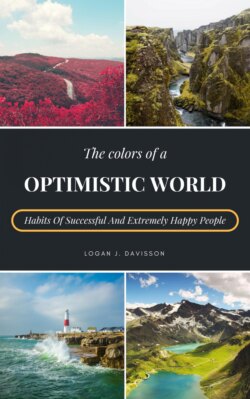Читать книгу The Colors Of A Optimistic World - Logan J. Davisson - Страница 21
На сайте Литреса книга снята с продажи.
Integrating new habits into everyday life
ОглавлениеMaybe you have heard the sentence "Then just don't get upset about it..." several times in your life. And how did this recommendation work out for you? Probably you just couldn't "just" not get excited, just couldn't "just" not get angry and so this sentence didn't make a big difference in your life. But why can't we just not get excited? Because our thoughts shape our emotions and a large part of our thoughts arise unconsciously and subconsciously.
So it's not surprising why we can't "just" stop worrying about the broken cell phone battery or the sold out favorite drink. So to achieve profound inner balance, more than just a small sentence is necessary and that is exactly what this chapter is about. Not all methods will suit you or please you - so choose the methods you like right away and practice them regularly. For just as you have built up negative subconscious and unconscious beliefs through constancy and regularity, you must now work with constancy and regularity on building positive beliefs. I recommend you to devote yourself to at least one method daily for 15 minutes and to increase this time slowly but surely.
After a few weeks you may return to this chapter and discover that a previously uninteresting method now sounds appealing after all. So don't exclude uninteresting methods for eternity at the moment, but stay open for these methods and dare to approach them at a later point in time. Each method has its own advantages and effects from which you can profit in the long run. How exactly you can integrate these methods into your everyday life, you can find out now!
Accepting a new habit
Maybe you are feeling great enthusiasm right now and would like to try out all the methods right now? I advise against this, because we need an average of 30 days to successfully integrate a new habit into our daily lives and until then learning a new habit is quite exhausting for us. So my tip is: Do not take more than one method per week. Sometimes it is even enough to devote a month to just one method and then try out another. Or you can immediately find the method that suits you perfectly and you can hide all other methods of learning inner balance. So this is your first task: to read through all methods carefully and to decide on a method. Go here according to your gut feeling and trust your intuition. It does not make sense to weigh up the advantages and disadvantages of each method very carefully, because in the end it depends less on the method than on your application!
The first 30 days is the integration of a new habit into everyday life quite a bit of work, after all you have to convince your body and mind daily of the importance of the new habit. I can say from my own experience that it is not easy to devote half an hour every day to meditation or yoga. Even if it is quite clear that this new habit will provide more relaxation and happiness in the long run. We humans are creatures of habit and prefer the quickly perceptible success, which is only limited in yoga, for example. Since these methods only address the short-term reward system to a limited extent, we need a lot of motivation until the new habit has actually become a habit and we feel the first long-term successes.
Application of different methods
In the following chapters you will learn different methods to increase your inner balance. These methods are divided into different areas: Relaxation techniques, reflection and everyday structures. As you know, changing everyday structures only makes limited sense, but can be an important means of restoring inner balance. Especially if you have too many appointments and obligations. Although these can be perceived as less stressful with a relaxed inner posture, they are nevertheless to be seen as an expression of unhealthy border-setting on an everyday level. And the re-setting of one's own limits happens with and through the building of inner balance.
The different relaxation techniques serve to provide you with a daily haven of peace in your everyday life. Unequal people do not only have the problem to be under stress all the time, but also take the opportunity to reduce this stress and to bring the body down from the state of stress again much too rarely. In this way, you will learn again and again to relax and to really treat yourself to the urgently needed time off. And the reflection? Reflection is enormously important in order to get to know oneself better, to find out the motives for action and to recognize fears more clearly. Through the regular practice of reflection, we increase our self-aware mindfulness and better perceive our needs. In addition to changing everyday structures and consciously perceiving relaxation units, reflection helps to work through and overcome the underlying fears of stress.
Together, these three factors have a strong effect, so you will quickly notice changes. In the first week it is advisable to try a relaxation method, in the second week to devote oneself to a reflection exercise and to start changing everyday structures in the third week at the earliest. Try a method for at least four weeks, because only then can you judge comprehensively whether this method really suits you. After one month you will notice some changes in your behaviour and thinking and probably experience a little more relaxation and balance in your everyday life. After the first month, you can add another new method to your everyday life at most once a week - less is more!
